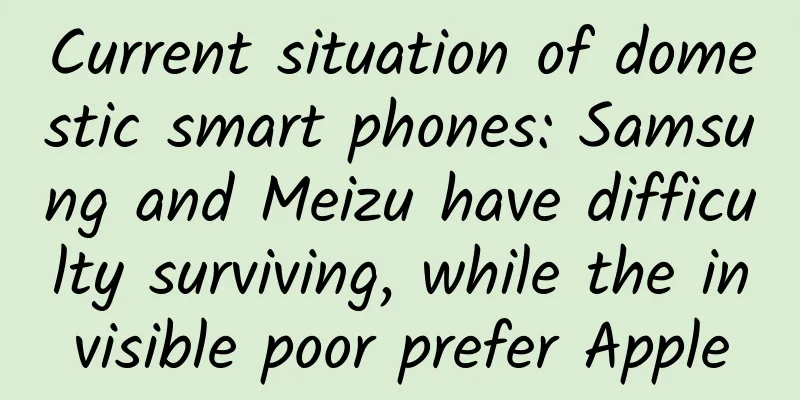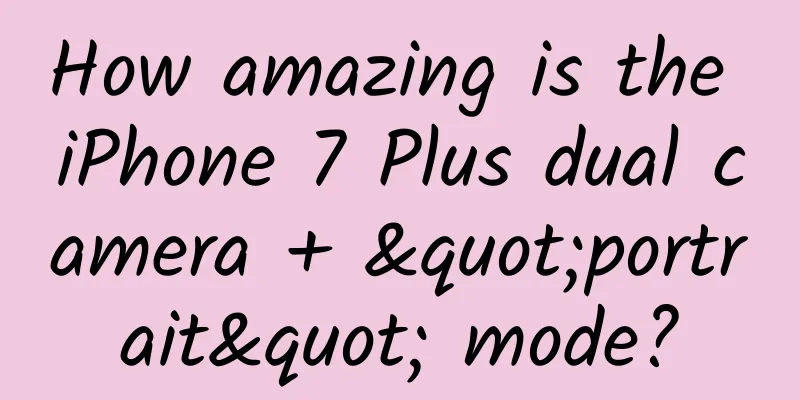Current situation of domestic smart phones: Samsung and Meizu have difficulty surviving, while the invisible poor prefer Apple

|
The current situation of domestic mobile phone users is that they mainly buy phones in two categories: either below 2,000 yuan or above 4,000 yuan. The statistics also show this level very well. In terms of smartphone selection, male users account for 49.9% of the entire market, and they prefer Apple and Huawei. Recently, domestic research organization MobData released an overview of the domestic smartphone market in the third quarter of 2018. Market competition has changed from the previous situation of a hundred flowers contending to a situation of many heroes vying for hegemony, and the monopoly situation has been further strengthened. This will be a disaster for small-brand mobile phone manufacturers because their market share is constantly being diluted. Apple leads the domestic market in the third quarter, Samsung, Meizu and other brands have difficulty surviving The top echelon accounted for 80.5% of the market share in the third quarter According to the data provided by MobData, in the third quarter of this year, Apple's users increased by 3.4% compared with Q2 (mainly due to the launch of the new iPhone XS series), and its market share reached 21.6% this quarter, followed by Huawei, OPPO, vivo and Xiaomi. The corresponding market shares this quarter were 18.7%, 17.1%, 13.2% and 9.9%. Except for Xiaomi, whose user base declined by 0.9%, the other three companies all saw growth, including Huawei's increase of 0.9%, OPPO and vivo's increases of 2.3% and 1.5%, and the top echelon accounted for 80.5% of the total domestic market in the third quarter. Compared with the first echelon mentioned above, the second echelon has a harder time surviving in the domestic mobile phone market. Samsung, Meizu, Gionee, LeTV and ZTE have market shares of 3%, 2.8%, 1.8%, 0.7% and 0.7% respectively this quarter. The user growth has all declined, with Samsung suffering the most severe decline of 2.2%. It was previously reported that Samsung's mobile phone shipments in China in the third quarter of this year were only 600,000 units, and it is expected that it will deliver no more than 3 million mobile phones in China this year. Current situation of domestic mobile phone market The current situation of mobile phones in China is that users’ purchases are mainly concentrated in two categories, either below 2,000 yuan or above 4,000 yuan. The statistics also show this aspect very well. Currently, the price range of OPPO, vivo and Huawei phones is basically around 1,000-1,999 yuan, and the three companies have the largest number of users in this price range, accounting for 58%, 41.8% and 32% respectively. Xiaomi phones are mainly priced below 1,000 yuan, accounting for 47.8% of users. Apple still focuses on the high-end market, with 98.5% of users spending more than 4,000 yuan. In terms of smartphone selection, male users account for 49.9% of the entire market, among which they prefer Apple and Huawei, which account for 11.5% and 11.3% respectively, while the female market accounts for 50.1%. Apple, OPPO and vivo are the most popular among female users, among which Apple accounts for 15%, while OV accounts for 9.9% and 8% respectively. In the market segments, the iPhone still has a huge advantage. In the markets of first-tier, new first-tier and second-tier cities, Apple still occupies an absolute leading position, while OPPO occupies the leading position in fourth- and fifth-tier cities. This is related to the deep penetration of their channels. Statistics of each brand and model For Apple, the proportion of old models in China is still very large. The number of users of iPhone 6S, 6S Plus and 7 Plus is on the rise. This is related to the fact that new models are sold at excessively high prices while the prices of old models are falling. In particular, the iPhone 6 currently accounts for 16.1% of the market share in the iPhone family. As for Huawei, OPPO and vivo, the concentration of their mobile phone models is very poor, especially Huawei, with a share of only 15.1%. This is related to the strategy of launching a large number of machines. OPPO and vivo account for more than 30% of this share, performing better than Huawei. Domestic users replaced their phones in the third quarter In addition, the report also lists the 10 most popular mobile phones replaced by domestic users in the third quarter, of which OPPO accounts for four models, namely R15 (1%), A83 (0.6%), A3 (0.6%), A5 (0.5%), while Xiaomi has two models, namely Xiaomi 8 (0.9%) and Xiaomi 6X (0.5%), vivo has three models on the list, namely X21A (0.8%), Y8*** (0.7%) and Y83A (0.5%), and Huawei brand has no models on the list, only Honor 10 (0.5%). In the third quarter, Android gradually gained popularity in the domestic smartphone market, with its market share gradually climbing from 67.8% to 75.4%, while iOS's share fell from 32.2% to 24.6%. At the same time, in terms of user replacement choices, users of mobile phones priced below 3,000 yuan concentrated on replacing phones in the 1,000-2,999 yuan range, while users of mobile phones priced above 3,000 yuan had relatively balanced replacement prices. Brand Loyalty Music and sports apps have a higher reach among Apple phone users, while Huawei users are more concerned with car services. In terms of brand loyalty, Apple ranks first, with 65.7% of iPhone users choosing Apple next time. The brand loyalty of OPPO, Xiaomi, vivo, and Huawei is around 30%, which is a big gap from Apple. Except for Xiaomi, the brand loyalty of users of the other three manufacturers is declining. Characteristics of user groups of each brand Domestic white-collar workers and people with a monthly income of more than 20,000 yuan prefer Huawei and Xiaomi, while students prefer Apple, OPPO and vivo. It is particularly noteworthy that a larger proportion of Huawei users have both houses and cars, while a larger proportion of Apple users do not have either houses or cars. Segmentation of the five major mobile phone brands To be more specific, the invisible poor people with a monthly income of less than 3k use iPhone the most, while those with a monthly income of 3-10k use OPPO and vivo more, and those with higher incomes use Xiaomi and Huawei more. |
<<: Have you ever thought about running Linux on iOS?
>>: 2019 iPhone wish list: Is there anything you want?
Recommend
Earn 300,000+ Yuan a year with violent money-making projects, and training on snack operations combining website SEO and bidding!
It is said that selling snacks can earn hundreds ...
Why do some advertisements make you want to move after watching them?
Have you seen ads like this: " U2 resin lens...
Xiamen Mini Program Agency, how much does it cost to be an agent for a wineware mini program?
How much does it cost to be an agent for a wine u...
No idea about product marketing on Xiaohongshu and Douyin? 7 selling point extraction rules
In 2021, platforms such as Douyin and Xiaohongshu...
Peach gum = cheap bird's nest? Is it really that magical?
In the spring, peach blossoms bloomed quietly, pe...
It is obviously a close relative of the cow, so why does it look so much like a deer?
Audit expert: Chen Yu Paleontological restoration...
How much does it cost to be an agent for a home furnishing mini program in Fuxin?
How much does it cost to be an agent for a home f...
Foshan small program software development outsourcing company_Foshan small program developer_software production_custom outsourcing company
What are the mini program outsourcing companies i...
One-stop video account operation + monetization_Qiuye
This course has been upgraded on March 9, 2021 an...
Tencent Cloud Analytics officially releases H5 application data statistics service platform
Recently, Tencent Cloud Analysis, a professional ...
Apple to launch Chinese version of operating system at the end of November
I just received a piece of news that will make Ap...
Will the next iPhone have an OLED screen? This Japanese company is the key
Next year, the iPhone will be 10 years old, and A...
Can domestic 4G chips withstand Qualcomm’s monopoly?
As the National Development and Reform Commission ...
It won’t degrade for 450 years. How harmful is it to discard masks carelessly?
Produced by: Science Popularization China Produce...
What are the functions of the Guangzhou attendance clock-in mini program? How to create a WeChat check-in app?
Not long ago, a customer consulted the editor. Si...









